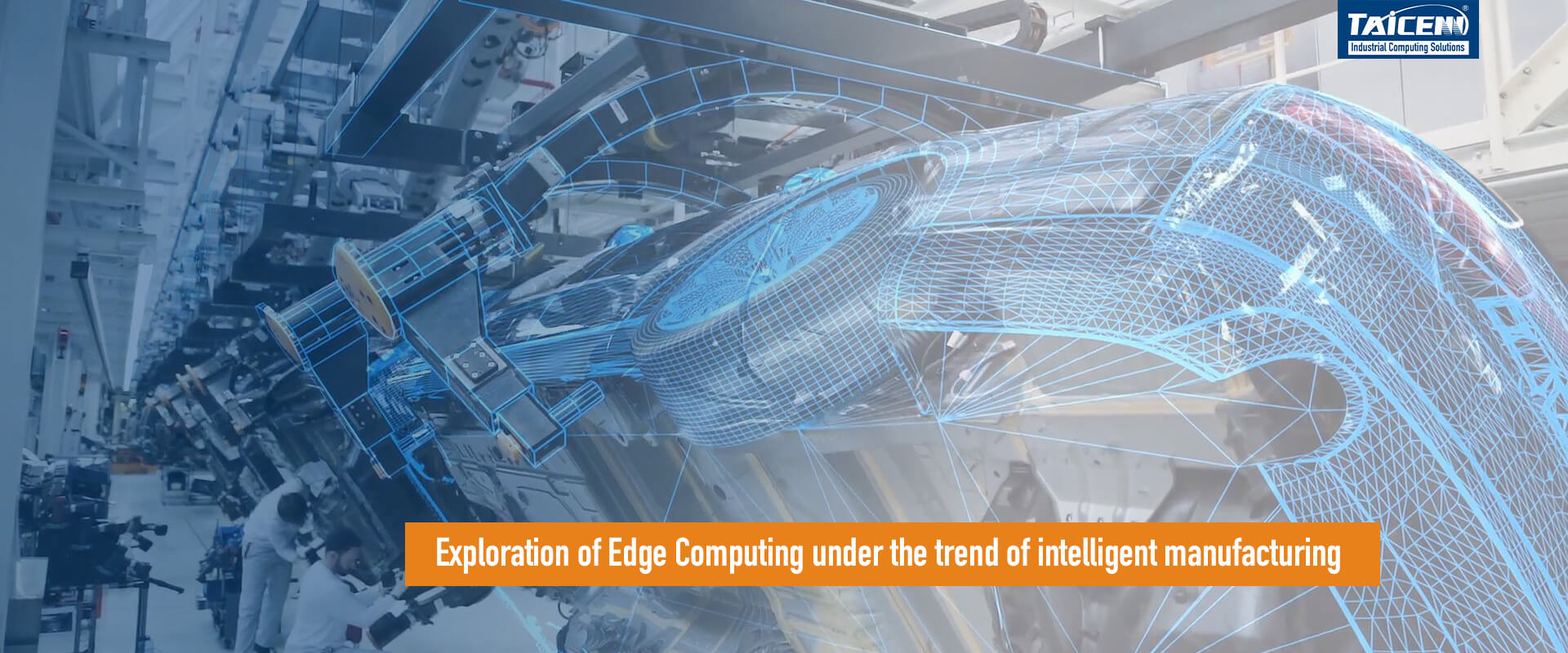Blog
Exploration of Edge Computing under the trend of intelligent manufacturing

Background:
With the proposal of Industry 4.0, more and more manufacturing enterprises around the world are carrying out industry 4.0 practice under the combination of cloud computing, big data, artificial intelligence and 5G technologies. In the process of digital, automation and intelligent transformation and upgrading of the traditional manufacturing industry, artificial intelligence technology is widely used in the research and development, design, manufacturing process and operation and maintenance stages of the manufacturing industry, so as to realize the automatic analysis, reasoning, judgment and decision-making of the whole life cycle of manufacturing products. Applying the previous cloud computing solutions, transferring all the data to the cloud data centers for computing has been difficult to meet the strict requirements of the factory field execution level on processing performance and efficiency. In order to meet the needs, the emergence of edge computing perfectly makes up for the requirements of rapid data processing and execution on the edge side.
What is edge computing?
Edge computing, as the name suggests, is doing computing at the edge end. It is an open platform near the end of objects or data, using the core capabilities of network, computing, storage and application, to provide the nearest end services nearby. Its applications are initiated on the edge side, generating faster network service response to meet the basic needs of the industry in real-time business, application intelligence, security and privacy protection. Edge computing decomposes the central node processing service, cuts it into smaller and more manageable parts, and spreads them to the edge nodes to process it. The edge node is closer to the user terminal device, which can speed up the data processing and transmission speed, reduce the delay, improve the efficiency, and improve the protection of security and privacy.
For example, as invertebrates, Octopuses have a large number of neurons, most of which are concentrated on the “eight legs”. Octopuses are particularly clever when hunting, with perfectly coordinated arms and no knots, thanks to their multiform distributed computing and can quickly make adjustments.
The core goal of intelligent manufacturing is to reduce costs and increase efficiency. Through various advance information technology, it can promote the manufacturing industry to digital, intelligent, personalized and customized, so as to realize digital transformation and bring better experience to end users. Edge computing is just a technology used in manufacturing industry for intelligent process, through which the digital transformation can be realized better and faster.
Advantages of edge computing:
Although the edge computing is far from commonplace, from the current surging undercurrent, we can already see the characteristics and trends.
- Ultra-low delay:
Huge amounts of data do not need to be uploaded to the cloud for processing, which greatly reduces network delay, makes faster feedback, improves user experience and reduces possible congestion in other parts of the network. - High bandwidth:
Since the edge data center is close to the information source, simple data processing can be carried out locally, without all the data to be uploaded to the cloud, which makes the transmission pressure of the core network decrease, reduce the network congestion, and the network transmission rate will be greatly increased. - High real-time computing:
Edge data center is the first entrance of data, which can undertake massive, heterogeneous and diversified data access, be responsible for simple business processing, and should have the real-time analysis and processing ability of massive access data. - More cost-effective and greener
A large number of high-frequency machine signal data can be timely processed and decided by the edge calculation in time, so in the network transmission, central operation, central storage, return transmission and other links, it can save a lot of server, bandwidth, power and even physical space, so as to achieve low cost and green. - Decentralization
From the perspective of the nature and definition of the industry, edge computing is to make the network, computing, storage, and applications distributed from the “center” to the edge, so as to provide intelligent edge services nearby.
Application scenario of edge computing in intelligent manufacturing:
- Edge computing and 5G combination to realize the factory AGV network
With the combination of 5G communication technology and edge computing network architecture, the problems of network stability and insufficient storage and computing power faced by the existing AGV application scenarios can be effectively solved. Edge computing gateways are deployed in the line edge or component logistics area nearest the AGV equipment, using distributed computing and storage capabilities to realize the local storage and real-time analysis of AGV data. Establish a fast-processing channel between the cloud and the AGV, working with the cloud platform to reduce the data processing cost, and improve the work efficiency and stability of the AGV in the workshop and the logistics area. - Achieve the edge line quality inspection by edge computing graphics processing ability
Take automobile manufacturing as an example. The factory has more than tens of millions of vehicles coming off the production line every day, and various parts flow continuously on the assembly line, assembled into different models according to the design process and delivered to the final customers. In this process, quality control is a key process. Quality inspection personnel have to complete the inspection of more than tens of millions of parts every day, detect dozens of parts almost every minute, and conduct the vehicle inspection before the machine goes off the production line. In the peak sales season, it is common for quality inspectors to work for more than 10 consecutive hours continuously.
In this mode of inspection, the quality inspection personnel have a large workload, personnel energy cannot keep up, easy to miss inspection, wrong inspection. Therefore, the automobile manufacturing enterprises have become an urgent problem to consider how to reduce the quality inspectors’ work pressure and improve the product quality.
Edge computing belongs to a distributed architecture, which can well collect, analyze and process data at the nearest line edge of the data, combined with deep learning, graph algorithm and AI technology, to form a set of effective intelligent graphic quality inspection solutions on the side of the industrial line. Using the EGX edge server such as Nvidia, reading quality inspection pictures in real time, analyzing picture content, positioning defects, judging the defect type, and conducting intelligent alarm without uploading all the data to the cloud for computing, causing the problem of excessive delay. This meets the business needs of nearby analysis, and also meets the requirements of production for network delay. At the same time, it can also be combined with the cloud platform to feedback these historical data to the cloud, do further analysis, and optimize the graph algorithm in the later edge computing.
Using edge computing network and graphical AI quality inspection scheme can quickly and accurately capture the common defects in quality inspection, and will not cause a large number of missed and wrong inspection, improve employee efficiency and improve the factory quality of products. - The Edge computing framework realizes the local processing of massive IoT data
In the factory workshop, the Internet of Things can range from manufacturing equipment to manufacturing parts, from sensor embedded automatic control to energy meter, from car to warehouse intelligent shelves, connect various manufacturing assets, improve the manufacturing efficiency, and make the factory more intelligent. At the same time, the traditional automobile enterprises are also transforming to digital transformation, gradually using their cars as intelligent terminals to provide more intelligent services that meet user needs. The Internet of vehicles is the most important terminal service mode for automobile enterprises. Edge computing is also one of the many core technologies of the Internet of Vehicles. Taking the car as the terminal, it collects, analyzes and quickly processes the data inside and outside the car to meet the needs of future autonomous driving.
Written at the end:
From the perspective of the development trend of intelligent manufacturing and digital transformation, the landing of edge computing in the field of intelligent manufacturing is inevitable, especially in the automobile manufacturing industry. As an effective supplement to cloud computing, edge computing has become the standard configuration of the data center in the future, coupled with the support of the Internet of Things, Internet of Vehicles, AI graphics processing, cloud computing, big data, artificial intelligence and other technologies, and has now become the best window for automobile manufacturing enterprises to transform into intelligent manufacturing enterprises. In the future, building an open edge computing platform to gather the edge computing advantages of all industries has become the development trend of edge computing, which is more conducive to accelerating the pace of digital transformation of enterprises.
With a dedication to technology innovation, TAICENN provides our customers qualified products and timely technical support, that the clients can safely deploy with ease and confidence, increasing their ability to bring products to market quickly, and decreasing the maintenance costs without any business risk.





.jpg)






